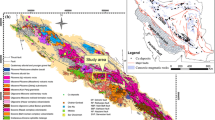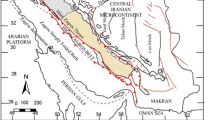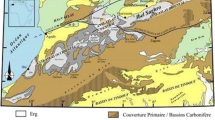Abstract
The Neoproterozoic basement complex of Egypt outcrops in the Eastern Desert (ED) and southern Sinai, and is regarded to represent the northwestern continuation of the Arabian–Nubian Shield (ANS). The area west of Berenice has been given little attention, although it represents the key to understanding the geologic history of the South Eastern Desert and the entire ED. The present work is an integrated study using remote sensing (Advanced Spaceborne Thermal Emission and Reflection Radiometer (ASTER) data imagery) and field-structural data to assess their utility in lithologic mapping and in detecting alteration mineral zones with considerable accuracy. A false-color-composite image, color-ratio composite image, decorrelation stretch, mafic index (MI), and quartz index (QI) were used to discriminate and map the various rock units. Correlation of False-color images of the ASTER band combination (7, 3, 1) with previous lithological mapping studies of the study area allow preliminary discrimination of different lithologies and drawing a base map. Subsequently, ASTER band ratios tested (4/1, 3/1, 12/14) and (4/7, 4/6, 4/10) with the ground truth data were used to refine the base map and construct the digital detailed geologic map. Petrographically, the investigated rock samples show kaolinite, chlorite, and epidote in alteration zones. The spectral angle mapper (SAM)-supervised classification using reference spectra of the USGS spectral library was used for detecting alteration zones. For verification, total accuracy assessment was carried out to evaluate the band combination and band ratios used in the lithologic mapping. That reached to 85.01% for band ratio 4/1, 3/1, 12/14 in RGB.

















Similar content being viewed by others
References
Abdeen MM, Thurmond AK, Abdelsalam MG, and Stern RJ (2001) Application of ASTER band-ratio images for geological mapping in arid regions: the Neoproterozoic Allaqi Suture, Egypt. In Proceedings of GSA 2001 Annual Meeting. Boston
Abdel-Khalek, M. L., Takla, M. A., Sehim, A., Hamimi, Z., and El Manawi, A. W., 1992. Geology and tectonic evolution of Wadi Beitan area, southeastern Desert, Egypt. Geology of the Arab World. Cairo University, 369–394
Aboelkhair H, Ninomiya Y, Watanabe Y, Sato I (2010) Processing and interpretation of ASTER TIR data for mapping of rare-metal-enriched albite granitoids in the Central Eastern Desert of Egypt. J Afr Earth Sci 58(1):141–151
Abrams M, Hook S, Ramachandran B (2002) ASTER user handbook, version 2. Jet propulsion laboratory 4800:135
Akaad , M. K., and El-Ramly , M. F., 1960. Geological history and classification of the basement rocks of the central Eastern Desert of Annals of the Geological Survey of Egypt, Paper. 9, 24pp
Akaad MK, Noweir AM (1969) Lithostratigraphy of the Hammamat umm Seleimat district, Eastern Desert, Egypt. Nature 223:284
Akaad MK, Noweir AM (1980) Geology and lithostratigraphy of the Arabian desert orogenic belt of Egypt between latitudes 25° 35′ and 26° 30′ N. Precambrian Res 6:A6
Alley, R. (1999). Algorithm theoretical basis document for: decorrelation stretch
Amer R, Kusky T, El Mezayen A (2012) Remote sensing detection of gold related alteration zones in Um Rus area, Central Eastern Desert of Egypt. Adv Space Res 49(1):121–134
Amer R, Kusky T, Ghulam A (2010) Lithological mapping in the Central Eastern Desert of Egypt using ASTER data. J Afr Earth Sci 56(2–3):75–82
Askari G, Pour A, Pradhan B, Sarfi M, Nazemnejad F (2018) Band ratios matrix transformation (BRMT): a sedimentary lithology mapping approach using ASTER satellite sensor. Sensors 18(10):3213
Asran AM, Emam A, El-Fakharani A (2017) Geology, structure, geochemistry and ASTER-based mapping of Neoproterozoic Gebel El-Delihimmi granites, Central Eastern Desert of Egypt. Lithofacies 282:358–372
ASTER Science Project Website, 2007. http://www.gds.aster.ersdac.or.jp/
Bedini E (2019) Application of WorldView-3 imagery and ASTER TIR data to map alteration minerals associated with the Rodalquilar gold deposits, southeast Spain. Adv Space Res 63(10):3346–3357
Conoco, C., 1987. Geological map of Egypt, scale 1: 500,000-NF 36 NE-Bernice, Egypt. The Egyptian General Petroleum Corporation, Cairo.
Di Tommaso I, Rubinstein N (2007) Hydrothermal alteration mapping using ASTER data in the Infiernillo porphyry deposit, Argentina. Ore Geol Rev 32(1–2):275–290
El Ramly MF (1972) A new geological map for the basement rocks in the eastern and southwestern desert of Egypt: scale 1: 1,000,000. Annals of the Geological Survey of Egypt
El Gaby S (1988) Geology, evolution and metallogenesis of the Pan-African belt in Egypt. The Pan-African belt of the northeast Africa and adjacent areas, 17–68
El Gaby S, List FK, and Tehrani R (1990) The basement complex of the Eastern Desert and Sinai. S. Rushdi (Ed.) The geology of Egypt, Balkema, Rotterdam, pp. 175–184
Elsaid M, Aboelkhair H, Dardier A, Hermas E, Minoru U (2014) Processing of multispectral ASTER data for mapping alteration minerals zones: as an aid for uranium exploration in Elmissikat-Eleridiya granites, Central Eastern Desert, Egypt. The Open Geology Journal 8(1)
Gabr SS, Hassan SM, Sadek MF (2015) Prospecting for new gold-bearing alteration zones at El-Hoteib area, South Eastern Desert, Egypt, using remote sensing data analysis. Ore Geol Rev 71:1–13
Gabr S, Ghulam A, Kusky T (2010) Detecting areas of high-potential gold mineralization using ASTER data. Ore Geol Rev 38(1–2):59–69
Gad S, Kusky T (2007) ASTER spectral ratioing for lithological mapping in the Arabian–Nubian shield, the Neoproterozoic Wadi Kid area, Sinai, Egypt. Gondwana Res 11(3):326–335
Gupta RP (2018) Remote sensing geology. 3rd Edition, Springer-Verlag GmbH Germany, 428
Hassan SM, Taha MM, Mohammad AT (2017) Late Neoproterozoic basement rocks of Meatiq area, Central Eastern Desert, Egypt: petrography and remote sensing characterizations. J Afr Earth Sci 131:14–31
Horning N (2010) Remote sensing for ecology and conservation: a handbook of techniques. Oxford University Press
Hume WF (1934) Geology of Egypt, Vol. 2, part I. The metamorphic rocks. Geol. Surv. Egypt, Cairo
Hunt GR (1977) Spectral signatures of particulate minerals in the visible and near infrared. Geophysics 42(3):501–513
Ibrahim WS, Watanabe K, Yonezu K (2016) Structural and litho-tectonic controls on Neoproterozoic base metal sulfide and gold mineralization in North Hamisana shear zone, South Eastern Desert, Egypt: the integrated field, structural, Landsat 7 ETM+ and ASTER data approach. Ore Geol Rev 79:62–77
Jakob S, Bühler B, Gloaguen R, Breitkreuz C, Eliwa HA, El Gameel K (2015) Remote sensing based improvement of the geological map of the Neoproterozoic Ras Gharib segment in the Eastern Desert (NE–Egypt) using texture features. J Afr Earth Sci 111:138–147
Johnson PR, Andresen A, Collins AS, Fowler AR, Fritz H, Ghebreab W, Stern RJ (2011) Late Cryogenian–Ediacaran history of the Arabian–Nubian shield: a review of depositional, plutonic, structural, and tectonic events in the closing stages of the northern East African Orogen. J Afr Earth Sci 61(3):167–232
Kalinowski A, Oliver S (2004) ASTER mineral index processing manual. Remote Sensing Applications, Geoscience Australia 37:36
Kruse FA, Lefkoff AB, Boardman JW, Heidebrecht KB, Shapiro AT, Barloon PJ, Goetz AFH (1993) The spectral image processing system (SIPS)—interactive visualization and analysis of imaging spectrometer data. Remote Sens Environ 44(2–3):145–163
Ninomiya Y, Fu B, Cudahy TJ (2005) Detecting lithology with advanced spaceborne thermal emission and reflection radiometer (ASTER) multispectral thermal infrared “radiance-at-sensor” data. Remote Sens Environ 99(1–2):127–139
Ninomiya Y, Fu B (2018) Thermal infrared multispectral remote sensing of lithology and mineralogy based on spectral properties of materials. Ore Geol Rev
Noori L, Pour AB, Askari G, Taghipour N, Pradhan B, Lee CW, Honarmand M (2019) Comparison of different algorithms to map hydrothermal alteration zones using ASTER remote sensing data for Polymetallic vein-type ore exploration: Toroud–Chahshirin Magmatic Belt (TCMB), North Iran. Remote Sensing 11(5):495
Pour AB, Hashim M, Hong JK, Park Y (2019a) Lithological and alteration mineral mapping in poorly exposed lithologies using Landsat-8 and ASTER satellite data: North-Eastern Graham Land, Antarctic Peninsula. Ore Geol Rev 108:112–133
Pour AB, Park Y, Crispini L, Läufer A, Kuk Hong J, Park TYS, Zoheir B, Pradhan B, Muslim AM, Hossain MS, Rahmani O (2019b) Mapping Listvenite occurrences in the damage zones of northern Victoria land, Antarctica using ASTER satellite remote sensing data. Remote Sensing 11(12):1408
Pour AB, Park Y, Park TYS, Hong JK, Hashim M, Woo J, Ayoobi I (2019c) Evaluation of ICA and CEM algorithms with Landsat-8/ASTER data for geological mapping in inaccessible regions. Geocarto Int 34(7):785–816
Pour AB, Park Y, Park TYS, Hong JK, Hashim M, Woo J, Ayoobi I (2018a) Regional geology mapping using satellite-based remote sensing approach in northern Victoria land, Antarctica. Polar Science 16:23–46
Pour AB, Hashim M, Park Y, Hong JK (2018b) Mapping alteration mineral zones and lithological units in Antarctic regions using spectral bands of ASTER remote sensing data. Geocarto Int 33(12):1281–1306
Rockwell BW, Hofstra AH (2008) Identification of quartz and carbonate minerals across northern Nevada using ASTER thermal infrared emissivity data—implications for geologic mapping and mineral resource investigations in well-studied and frontier areas. Geosphere 4(1):218–246
Salem SM, El Sharkawi M, El-Alfy Z, Soliman NM, Ahmed SE (2016) Exploration of gold occurrences in alteration zones at Dungash district, Southeastern Desert of Egypt using ASTER data and geochemical analyses. J Afr Earth Sci 117:389–400
Schurmann HME (1957) The Precambrian of Egypt east of the River Nile. Geol and Minjbeuw, 19th year, No. 5, 165–171
Sheikhrahimi A, Pour AB, Pradhan B, Zoheir B (2019) Mapping hydrothermal alteration zones and lineaments associated with orogenic gold mineralization using ASTER data: a case study from the Sanandaj-Sirjan zone, Iran. Adv Space Res 63(10):3315–3332
Stern RJ (1994) Arc assembly and continental collision in the Neoproterozoic East African Orogen: implications for the consolidation of Gondwanaland. Annu Rev Earth Planet Sci 22(1):319–351
Stern RJ (2002) Subduction zones. Rev Geophys 40(4):3–1
Sun T, Chen F, Zhong L, Liu W, Wang Y (2019) GIS-based mineral prospectivity mapping using machine learning methods: a case study from Tongling ore district, eastern China. Ore Geol Rev 109:26–49
Zoheir B, Emam A (2012) Integrating geologic and satellite imagery data for high-resolution mapping and gold exploration targets in the south Eastern Desert, Egypt. J Afr Earth Sci 66:22–34
Zoheir B, El-Wahed MA, Pour AB, Abdelnasser A (2019) Orogenic gold in transpression and transtension zones: field and remote sensing studies of the Barramiya–Mueilha sector. Egypt Remote Sens 11:2122
Author information
Authors and Affiliations
Corresponding author
Additional information
This article is part of the Topical Collection on Current Advances in Geological Research of Egypt
Rights and permissions
About this article
Cite this article
Aboelkhair, H., Abdelhalim, A., Hamimi, Z. et al. Reliability of using ASTER data in lithologic mapping and alteration mineral detection of the basement complex of West Berenice, Southeastern Desert, Egypt. Arab J Geosci 13, 287 (2020). https://doi.org/10.1007/s12517-020-5227-x
Received:
Accepted:
Published:
DOI: https://doi.org/10.1007/s12517-020-5227-x




